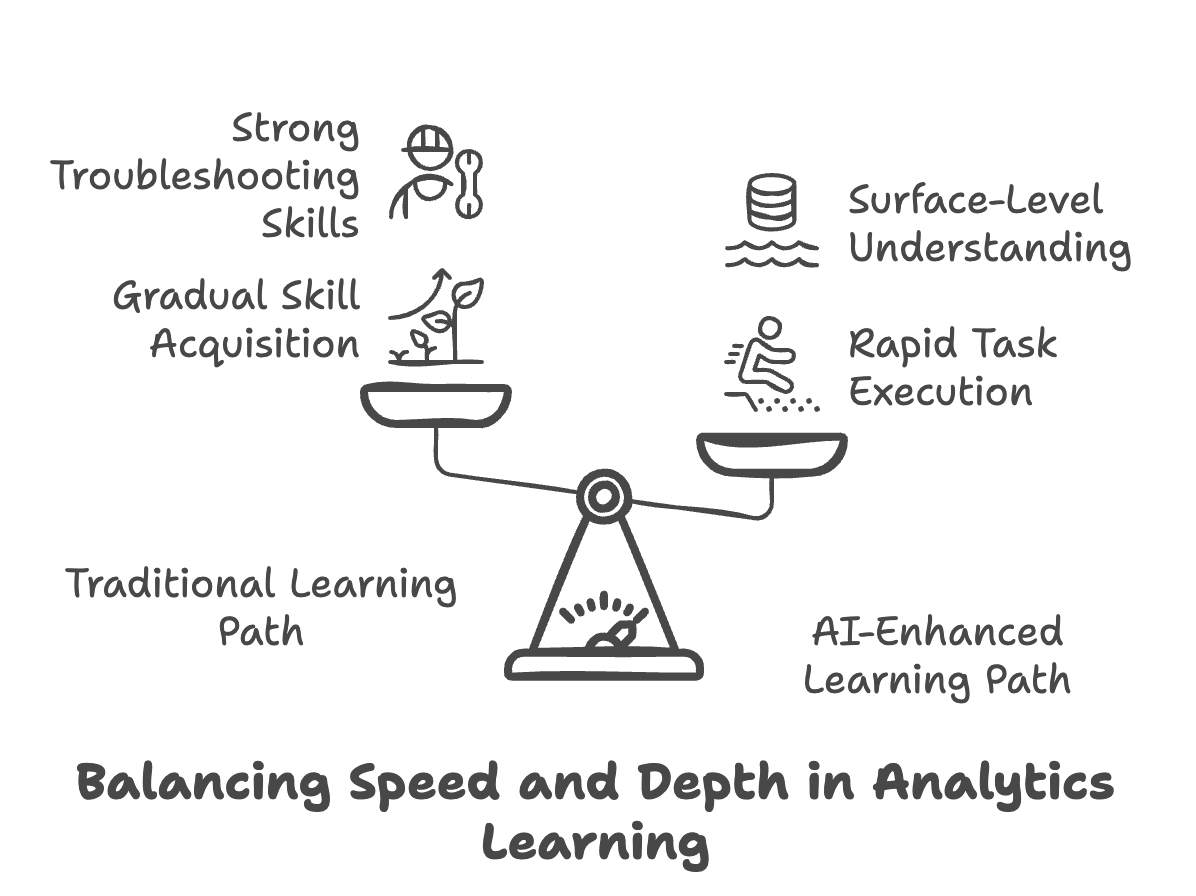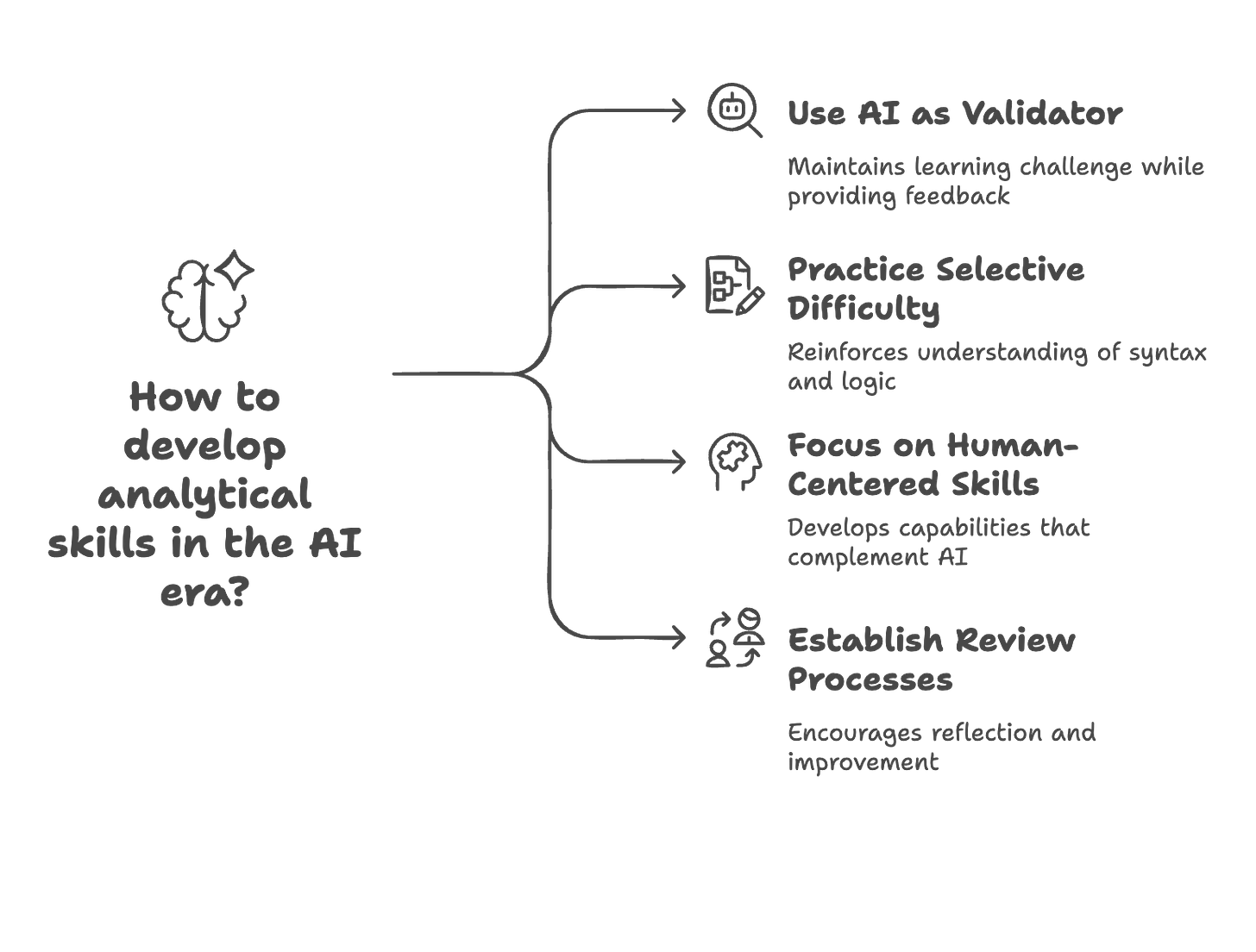The Learning Paradox: Developing Analytics Talent in the AI Era
As AI makes data work easier, ensuring deep expertise becomes harder. Here's how to find the right balance.
"Cursor f*cked up my 4 months of works."
This desperate Reddit post caught my eye last week – a developer who had leveraged AI-powered coding to build a project over several months, only to see it vanish with a single misplaced command. The developer hadn't established basic Git version control, a foundational skill most programmers learn in their first weeks of training.
The irony wasn't lost on me. In the last post, I shared how Cursor helped me build three applications in record time after a 4-year coding hiatus. AI coding tools are transformative, but as this cautionary tale demonstrates, they create a fascinating paradox: the same tools that accelerate our work can inadvertently short-circuit essential learning.
This incident crystallizes the challenge analytics teams face today: How do we harness AI's incredible efficiency while ensuring team members develop the foundational skills needed to make the most out of their AI copilot?
When Easy Becomes Too Easy
Remember your first data job? If you're like me, you probably spent countless hours cleaning messy data, writing (and rewriting) SQL queries, and building reports that weren't quite right. These tasks weren't just about getting work done – they were essential learning experiences that built your foundational skills through good old-fashioned trial and error.
Today, that landscape has fundamentally shifted. What once took days of productive struggle can now be accomplished in minutes with the right prompts. While this acceleration of work is impressive, it creates an interesting challenge: How do you develop deep understanding when AI can handle the basics?
The New Learning Curve: Not Your Standard SQL Tutorial
I've noticed a fascinating pattern emerging in analytics teams, including my own. I have seen junior team members producing code and analyses faster than ever, yet sometimes struggling when systems break or edge cases appear. It's not that they lack intelligence, talent or dedication – it's that their learning journey has fundamentally changed.
In the traditional analytics learning path, the progression was relatively straightforward:
You'd start with simple SELECT statements, gradually adding JOINs and subqueries as you built confidence. You'd create basic charts before tackling complex dashboards. Each step built naturally on the last, creating a solid foundation of knowledge through sustained practice and occasional failures. The skills developed through this gradual progression – especially troubleshooting and debugging – became invaluable as problems grew more complex.
Today's learning landscape is radically different. With AI tools generating complex code on demand, analysts can begin their journey with advanced concepts like window functions and statistical models without necessarily understanding the fundamentals behind them. On the one hand that enables people to contribute meaningful results early on, on the other hand they are wielding powerful tools without knowing the proper technique.
This disruption of the traditional learning sequence creates a fascinating paradox: we can produce sophisticated work faster than ever, but might be building on shaky foundations. It's like learning to drive in a vehicle with advanced driver assistance – you can navigate effectively in ideal conditions, but might not develop the instincts needed when systems fail or conditions change.
The traditional learning ladder now has some critical middle rungs missing. The question becomes: how do we ensure analysts develop both speed and depth when the natural progression of difficulty has been short-circuited?
What's often missing is learning from first principles - understanding why certain approaches work rather than just that they work. First-principles thinking enables analysts to break down complex problems into their fundamental components, reason from the ground up, and build solutions based on core truths rather than pattern matching or templates. This type of thinking allows analysts to adapt when facing novel problems, build intuition about data relationships, and develop confidence in their technical judgments. These capabilities become essential when AI-generated solutions fail or when unprecedented business questions arise.
Finding the Sweet Spot: When to Embrace the Struggle
Here's where things get interesting. Think about learning to ride a bike. While training wheels prevent falls, they also delay mastering the real skill of balancing. The same principle applies to learning new skills in the workplace – we learn best through what's called the "Goldilocks effect," where tasks are neither too easy nor too hard, but "just right."
AI tools, however, can accidentally remove this productive struggle. When ChatGPT can instantly generate a perfect SQL query or Claude can fix the bug in your Python code, it's like having training wheels that never come off. You only get as far as AI takes you – and no further. Sure, you'll get to your destination, but you might miss out on developing crucial skills along the way:
The pattern recognition that comes from debugging your own code
The deep understanding of why certain approaches work better than others
The intuition about data structures that only develops through hands-on experience
The confidence that comes from solving complex problems on your own
Eventually, a cyclist needs to remove the training wheels to develop true mastery. They might fall occasionally, but each fall teaches valuable lessons about balance and control that can't be learned any other way. Similarly, learners need moments of productive struggle – writing code from scratch, troubleshooting their own errors, and reasoning through complex problems – to develop the expertise that makes them truly effective. This creates a tricky balance: how do we leverage AI's power while ensuring we're occasionally taking off the training wheels to develop deep, independent expertise?
Making Analytics Learning Work in the AI Era
Through experimentation with our team, we've discovered approaches that help develop strong analytical skills while leveraging AI's benefits. Here's what works at different levels:
Use AI as a Validator, Not a Generator: Write your own solutions first, then use AI to check and improve them. This maintains the learning challenge while providing valuable feedback. For instance, if you're crafting a complex SQL query, write it yourself first, then ask AI to review it for optimization, potential errors, or alternative approaches.
Practice Selective Difficulty: Choose specific areas where you'll intentionally work without AI assistance. If you're learning a new programming language, try writing small scripts or functions without AI autocomplete to reinforce syntax and logic understanding.
Focus on What AI Can’t Do: AI excels at generating code and identifying patterns, but struggles with defining problems worth solving and connecting insights to business value. By focusing learning efforts on these human-centered skills, analysts develop capabilities that complement AI rather than compete with it.
Establish Review Processes: Create checkpoints where team members explain not just what they did, but how and why. Questions we ask: How did you break down the problem? Where did you use AI assistance? What would you do differently next time?
The silver lining in all this change is significant: AI handling routine tasks frees up time for more strategic work earlier in careers. Junior analysts can now contribute meaningful insights much faster than before, assuming they develop the right skills to work effectively with AI. Rather than spending months mastering syntax, they can focus on learning the business context that makes their analyses truly valuable.
Building the Future of Analytics Learning
The AI revolution isn't just reshaping our workflows – it's fundamentally transforming how we learn and grow as professionals. This transformation brings both opportunity and challenge: while AI has disrupted traditional learning paths, it's also unlocked unprecedented potential for rapid skill development and impact. The key lies not in choosing between human expertise and AI capabilities, but in mastering their synergy.
As we look to the future, analytics talent development is evolving into something remarkable – a powerful fusion of deep technical understanding and AI-enhanced capabilities. The most successful analysts won't be those who simply lean on AI as a crutch, nor those who stubbornly resist it. Instead, they'll be the ones who embrace AI as a partnership, maintaining their intellectual curiosity while leveraging AI to amplify their capabilities. Think of it as developing a new kind of literacy – one that combines human insight with machine intelligence.
I'm curious to hear your perspective on this evolving landscape. How is your team navigating the balance between AI assistance and fundamental skill development? What strategies have proven effective (or surprisingly ineffective) in your experience? Share your thoughts below – let's learn from each other's journeys in this fascinating new era.



